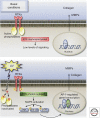Natural and sun-induced aging of human skin
- PMID: 25561721
- PMCID: PMC4292080
- DOI: 10.1101/cshperspect.a015370
Natural and sun-induced aging of human skin
Abstract
With worldwide expansion of the aging population, research on age-related pathologies is receiving growing interest. In this review, we discuss current knowledge regarding the decline of skin structure and function induced by the passage of time (chronological aging) and chronic exposure to solar UV irradiation (photoaging). Nearly every aspect of skin biology is affected by aging. The self-renewing capability of the epidermis, which provides vital barrier function, is diminished with age. Vital thermoregulation function of eccrine sweat glands is also altered with age. The dermal collagenous extracellular matrix, which comprises the bulk of skin and confers strength and resiliency, undergoes gradual fragmentation, which deleteriously impacts skin mechanical properties and dermal cell functions. Aging also affects wound repair, pigmentation, innervation, immunity, vasculature, and subcutaneous fat homeostasis. Altogether, age-related alterations of skin lead to age-related skin fragility and diseases.
Copyright © 2015 Cold Spring Harbor Laboratory Press; all rights reserved.
Figures



References
-
- Agrawal A, Agrawal S, Cao JN, Su H, Osann K, Gupta S 2007. Altered innate immune functioning of dendritic cells in elderly humans: A role of phosphoinositide 3-kinase-signaling pathway. J Immunol 178: 6912–6922. - PubMed
-
- Armulik A, Abramsson A, Betsholtz C 2005. Endothelial/pericyte interactions. Circ Res 97: 512–523. - PubMed
-
- Baadsgaard O, Lisby S, Wantzin GL, Wulf HC, Cooper KD 1989. Rapid recovery of Langerhans cell alloreactivity, without induction of autoreactivity, after in vivo ultraviolet A, but not ultraviolet B exposure of human skin. J Immunol 142: 4213–4218. - PubMed
-
- Bennett MF, Robinson MK, Baron ED, Cooper KD 2008. Skin immune systems and inflammation: Protector of the skin or promoter of aging? J Invest Dermatol Symp Proc 13: 15–19. - PubMed
Publication types
MeSH terms
Substances
Grants and funding
LinkOut - more resources
Full Text Sources
Other Literature Sources
Medical
